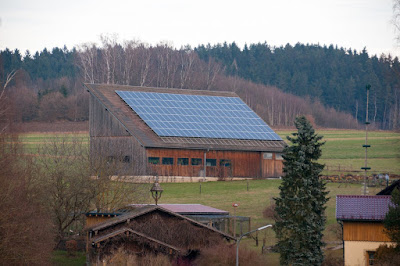Rooftop Solar ROI
The idea of putting solar panels on the roof
of your home is very appealing. Once installed, the can produce free
electricity for decades. Who doesn’t like free?
Rooftop solar systems themselves are not free,
however. The first question most homeowners ask is, “How long will it take to
for the system to pay for itself?” The answer to that question depends on many variables.
Here are some of them.
- The cost of the system
- The price of electricity in your area
- The efficiency of your solar panels
- Federal, state, and local rebates and incentives
- Local utility company policies
Let’s take them one at a time.
The
Cost of Your System
No two rooftop solar systems are the same, so
no two systems will cost the same. But on average, the typical residential
solar installation in the United States has a capacity of 6,000 watts. Since
the average installed cost is $3.14 per watt, that typical system has a gross
cost of $18,840.
Notice that price does not include available
rebates and incentives. We’ll get into those in greater detail in a minute.
Those rebates and incentives could bring the net cost of that 6,000 watt system
to $13,188.
How
Much Are You Paying For Electricity?
According to the US Energy Information Agency,
the average cost of electricity in the United States is 12 cents per kilowatt
hour. A kilowatt hour is how much electricity it takes to light 10 100 watt
conventional light bulbs for 60 minutes. Across the US, the average household
consumes 908 kilowatt-hours of electricity each month.
The cost of electricity varies widely in
America from a high of 33 cents per kWh in Hawaii to just 8 cents per kWh in
Idaho. Naturally the higher the cost of electricity in your area, the more
valuable the electricity produced by your rooftop solar system will be and the
shorter the time needed to repay your investment.
The
Efficiency of Your Solar System
Not all solar panels are the same. Some
produce more electricity from a given amount of sunlight than others. In
general, the more efficient the panels on your roof are, the sooner you can recover
the cost of the system.
To put it in practical terms, a solar panel
that is 21% efficient will produce 50% more electricity than one that is only
14% efficient. Generally speaking, the average efficiency of a typical solar
panel for residential use is around 16%. Of course, more efficient panels cost
more, increasing the cost of the system they are part of.
Rebates
and Incentives
The federal government currently offers
homeowners a 30% tax credit for residential solar systems. That’s why that
$18,840 system referred to above has a net cost of just $13,188. But beware
that the federal tax credit is not permanent. Unless renewed or revised by
Congress, it is scheduled to drop to 26% in 2020 and 22% in 2021. After that, it
will be eliminated entirely.
Obviously, it will take much longer for your
rooftop solar system to pay for itself once the federal credit is reduced or
terminated. Waiting for the price of rooftop solar to go down may wind up
costing you quite a bit more money in the long run.
Some states and cities have additional rebates
or tax credits available and some utility companies have incentive programs for
customers as well. A qualified solar installer can tell you more about what
incentives and rebates are available in your area.
Local
Rules Can Have a Big Impact
Not every utility company welcomes new
residential solar systems. Some assess a monthly fee on customers who make
their own electricity, claiming they are not paying their fair share to help
maintain the electrical grid.
Others offer what is called net metering. When
your solar system generates more electricity than your home needs, you can sell
the excess back to your local utility and get paid for it. How much you get paid is something that
varies widely from one part of the country to another. Some utilities pay the
prevailing rate; others pay the wholesale rate, while some pay below wholesale.
Net metering is becoming less popular with
utility companies. Many have eliminated this benefit entirely.
The
Wrap Up
How long will it take for that solar system
you are thinking about installing on your roof to pay for itself? The answer
is, it is impossible to say precisely, as every case will be different. But you
can get an approximate idea using average numbers.
A solar panel that is 20% efficient can
generate about 30 kWh of electricity each month. At 12 cents per kWh, that’s
worth about $3.60 a month. Multiply that by the number of panels in your system
to get an approximate idea of how much revenue your system will generate each
month. Then divide that number into $13,180 to determine how many months will
be needed to recover the cost of the system.
In the end, the best decision you can make
when considering a rooftop solar system is to work with a reputable solar
system installer you have trust and confidence in. Now that you know what
questions to ask, you have a better chance of getting answers to your financial
questions so you will know if rooftop solar is the right solution for you.
To know more: https://www.costofsolar.com/

Comments
Post a Comment